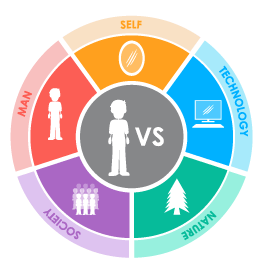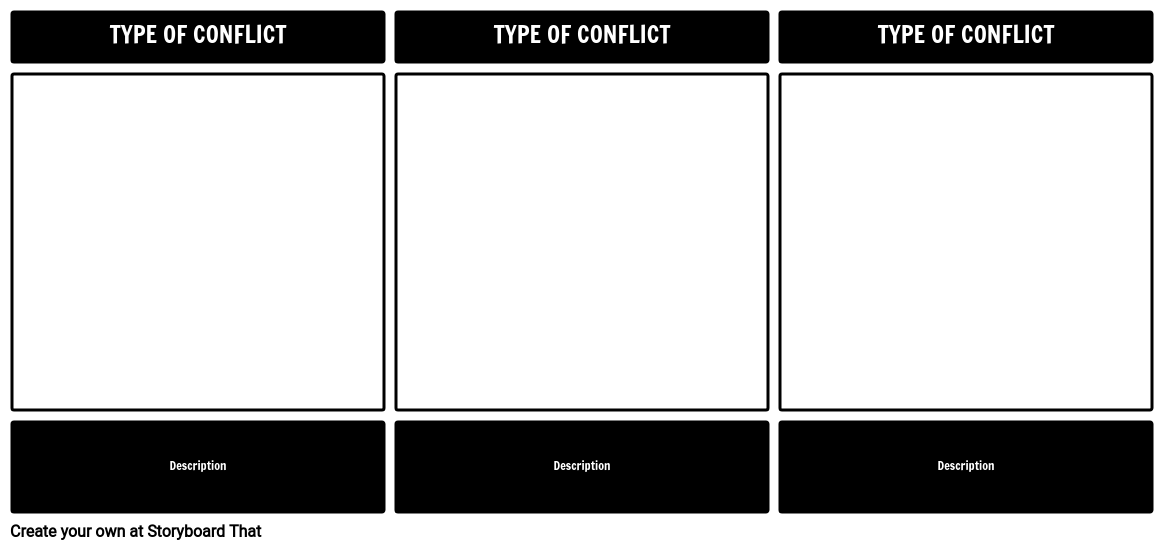Try and Try Again Mr White
https://www.storyboardthat.com/lesson-plans/the-monkeys-manus-by-ww-jacobs/literary-conflict

Activity Overview
Storyboarding is an fantabulous way to focus on types of literary conflicts.
Having students create storyboards that show the cause and effect of unlike types of conflicts strengthens analytical thinking about literary concepts. Accept your students choose an example of each literary conflict and depict them using the storyboard creator. In the storyboard, an instance of each disharmonize should be visually represented, forth with an explanation of the scene, and how it fits the item category of conflict.

Human vs. Homo
Sergeant Major Morris knows that the paw brings mischief, so he throws it into the fire. Mr. White, however, wants to try his luck with the paw so he saves it, in spite of Morris' insistence to let it burn.
Man vs. Cocky
While Mr. White knows the dangers of the paw, he risks it to become his son back. However, when he hears the ominous knocking on the door, he knows that his wish has been granted in a twisted way. Despite the fact that his son could potentially exist outside, he wishes for his son to be dead again.
Homo vs. NATURE
When Mr. White makes his wish on the paw, he is interfering with the way that things are supposed to be. Because of his interference with fate, he is punished by losing his son and and so having him brought back to life in a zombie-like country.
Pupil Instructions
Create a storyboard that shows at least three forms of literary conflict in "The Monkey'south Paw".
- Place conflicts in "The Monkey's Paw".
- Categorize each conflict every bit Graphic symbol vs. Character, Character vs. Self, Character vs. Society, Character vs. Nature, or Character vs. Technology.
- Illustrate conflicts in the cells, using characters from the story.
- Write a short description of the conflict below the jail cell.

Lesson Plan Reference
Common Core Standards
- [ELA-Literacy/RL/nine-ten/3] Clarify how circuitous characters (e.g., those with multiple or conflicting motivations) develop over the course of a text, interact with other characters, and advance the plot or develop the theme
- [ELA-Literacy/RL/ix-10/5] Analyze how an author'southward choices apropos how to structure a text, order events within information technology (e.yard., parallel plots), and manipulate time (e.m., pacing, flashbacks) create such furnishings as mystery, tension, or surprise
- [ELA-Literacy/RL/9-10/6] Analyze a detail betoken of view or cultural experience reflected in a work of literature from outside the United States, drawing on a wide reading of world literature
Create a storyboard that shows at least three forms of literary conflict from the story. Support your choices with evidence from the text.
| Proficient | Emerging | Outset | Try Over again | |
|---|---|---|---|---|
| Disharmonize Identification | Student identifies right major conflicts and uses strong, clear textual evidence to back up choice. | Student identifies correct major conflict and uses few or unclear details to support their option. | Educatee identifies incorrect major conflict, and uses some details from the text to support their pick. | Student does not effort to place major conflict or identifies incorrect major conflict with no explanation. |
| Agreement Event | Student conspicuously shows the effect of the conflict and its furnishings on the protagonist with evidence from the text. | Pupil shows the outcome of the disharmonize and its effect on the protagonist, just some evidence is unclear. | Student shows the outcome of the conflict, but does not examine its effect on the protagonist and uses some vague textual evidence. | Student does not conspicuously bear witness the consequence of the conflict or apply textual show. |
| Character | Storyboard includes all required characters and clearly names them. Goes above and across by adding additional details. | Storyboard includes all required characters and conspicuously names them. | Storyboard includes protagonist and antagonist but leaves out other required characters. | Storyboard does not include the names of required characters. |
| Storyboard | Student conspicuously shows effort to convey the setting the scene of the book | Student attempts to convey setting and scene of the book, only lacks some clarity. | Student does not clearly convey the setting and scene. | Student makes little or no attempt to convey the setting or scene. |
| Spelling and Grammar | Student uses exemplary spelling and grammar. There are no errors. | Educatee makes a pocket-size error in spelling and grammer. | Student makes several modest errors in spelling and grammar. | Student makes many errors in spelling and grammer; little try at spellchecking. |
*(This Volition Starting time a two-Week Free Trial - No Credit Card Needed)
https://www.storyboardthat.com/lesson-plans/the-monkeys-paw-by-ww-jacobs/literary-disharmonize
© 2022 - Clever Prototypes, LLC - All rights reserved.
Source: https://www.storyboardthat.com/lesson-plans/the-monkeys-paw-by-ww-jacobs/literary-conflict
0 Response to "Try and Try Again Mr White"
Post a Comment